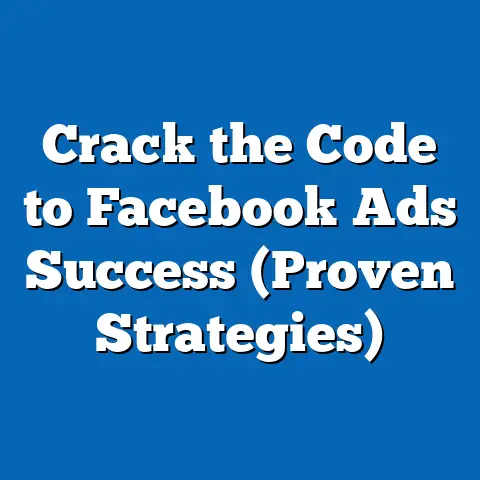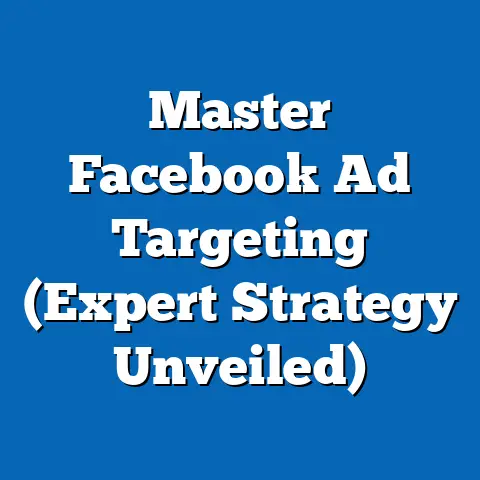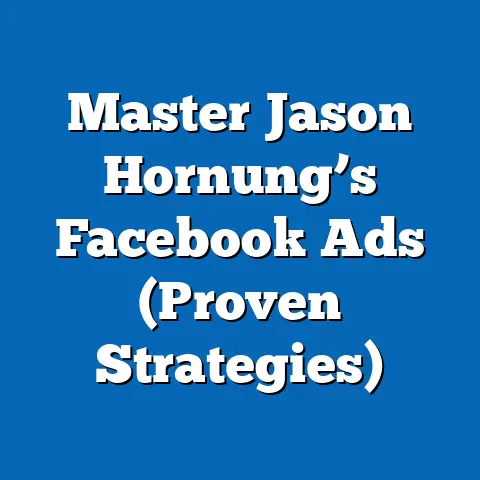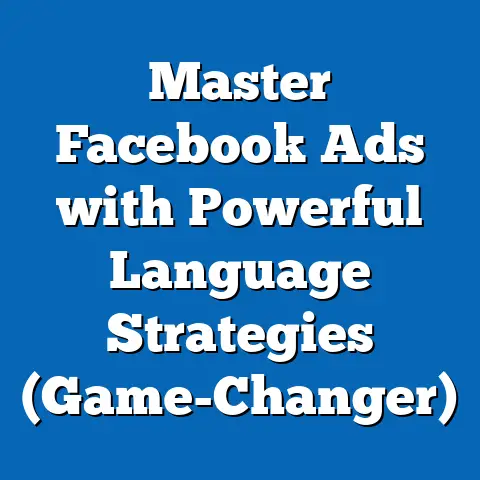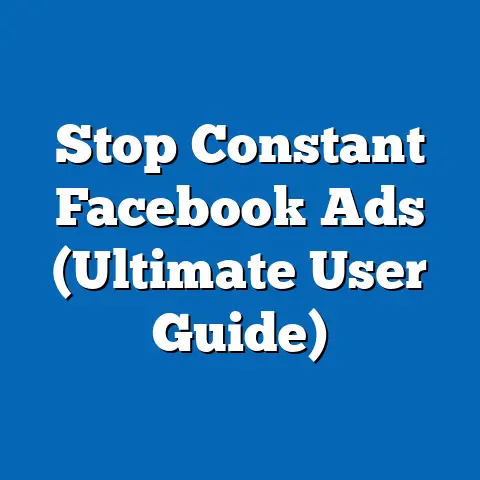Master Facebook In-Stream Ads: Essential Game-Changers (Pro Tips)
Video is king. It’s a phrase I’ve heard echoed in countless marketing conferences and read in countless industry reports. And it’s true! In today’s digital landscape, video content reigns supreme. It grabs attention, conveys emotions, and delivers information in a way that static images and text simply can’t match. That’s why Facebook in-stream ads are such a powerful tool for businesses. They allow you to seamlessly integrate your message into the video content that people are already watching, capturing their attention in a natural and engaging way.
But let’s be honest, simply throwing a video ad out there and hoping for the best rarely works. To truly harness the power of Facebook in-stream ads, you need a strategy, a deep understanding of the platform, and a willingness to experiment. It’s about more than just having a good video; it’s about crafting a compelling message, targeting the right audience, and optimizing your campaigns for maximum impact.
Think of it like this: you’re trying to catch a fish in a vast ocean. You need the right bait (compelling content), the right location (targeted audience), and the right technique (optimized campaign) to reel in your target.
That’s where this article comes in. I’m going to share with you the essential game-changing pro tips to master Facebook in-stream ads. By the end of this guide, you’ll have a solid understanding of how to create, optimize, and analyze your in-stream ad campaigns, leading to better marketing outcomes, increased return on investment (ROI), and improved audience engagement. Let’s dive in!
1: Understanding Facebook In-Stream Ads
Before we get into the nitty-gritty of setting up and optimizing your campaigns, let’s make sure we’re all on the same page about what Facebook in-stream ads actually are.
What are Facebook In-Stream Ads?
Facebook in-stream ads are short video ads that play before, during, or after other video content on Facebook. Think of them as the commercials you see on television, but tailored for the digital age. These ads are embedded within videos that users are already watching, offering a non-intrusive way to reach your target audience.
I remember the first time I saw an in-stream ad that really resonated with me. I was watching a cooking video, and a pre-roll ad for a local kitchen supply store popped up. The ad was short, visually appealing, and featured a product that was directly relevant to the content I was watching. It felt like a natural extension of the video, rather than a disruptive interruption. That’s the power of well-executed in-stream advertising.
Different In-Stream Ad Formats
Facebook offers several different in-stream ad formats, each with its own unique advantages:
- Pre-roll Ads: These ads play before the main video content. They are often the most impactful, as they capture the viewer’s attention right from the start. However, they also need to be highly engaging to prevent viewers from skipping them (if the option is available).
- Mid-roll Ads: These ads play during the main video content. They can be a good option if you want to reach viewers who are already invested in the video. The key is to ensure that the ad is relevant to the video content and doesn’t disrupt the viewing experience too much.
- Post-roll Ads: These ads play after the main video content. They can be a good option for reaching viewers who have watched the entire video and are therefore more likely to be interested in your message.
Leveraging Facebook’s Targeting Capabilities
One of the biggest advantages of Facebook advertising, in general, is its incredibly granular targeting capabilities. With in-stream ads, you can leverage this to reach specific demographics, interests, behaviors, and even custom audiences.
For example, let’s say you are selling a fitness product. You can target people who are interested in fitness, health, and wellness, or even those who have liked pages related to specific fitness brands. You can also create custom audiences based on your existing customer data, website visitors, or people who have interacted with your previous Facebook posts or ads.
By carefully targeting your in-stream ads, you can ensure that your message is reaching the people who are most likely to be interested in your product or service, significantly increasing your chances of success.
Key Takeaway: Facebook in-stream ads are a powerful way to reach your target audience within the video content they are already watching. Understanding the different formats and leveraging Facebook’s targeting capabilities are crucial for success.
2: Setting Up Your Facebook In-Stream Ads
Okay, now that you understand the basics of Facebook in-stream ads, let’s get practical and walk through the process of setting them up.
Step-by-Step Guide to Setting Up In-Stream Ads
- Create a Facebook Business Manager Account: If you don’t already have one, you’ll need to create a Facebook Business Manager account. This is the central hub for managing your Facebook advertising activities. I’ve found it essential for keeping my personal and professional Facebook activities separate and organized. You can access Business Manager at business.facebook.com.
- Prepare Your Video Content: Make sure you have high-quality video content that is optimized for in-stream placements. This means ensuring that your video is visually appealing, has clear audio, and is the right length for the format you’re using (e.g., shorter for pre-roll, slightly longer for mid-roll).
- Create a New Campaign: In Facebook Ads Manager, click on the “+ Create” button to create a new campaign.
-
Select Your Campaign Objective: Choose an objective that aligns with your marketing goals. Common objectives for in-stream ads include:
- Brand Awareness: To reach people who are likely to remember your brand.
- Reach: To show your ad to the maximum number of people.
- Traffic: To drive traffic to your website or landing page.
- Video Views: To get more people to watch your video.
- Conversions: To drive specific actions on your website, such as purchases or sign-ups.
- Set Your Audience Targeting: Define your target audience based on demographics, interests, behaviors, or custom audiences. Be as specific as possible to ensure that your ads are reaching the right people.
- Choose Your Placements: In the “Placements” section, select “Manual Placements” and then choose “Facebook In-Stream Videos.” This ensures that your ads will only appear within in-stream placements.
- Set Your Budget and Schedule: Determine how much you want to spend on your campaign and how long you want it to run. You can set a daily budget or a lifetime budget.
- Create Your Ad: Upload your video, write your ad copy, and add a call-to-action button. Make sure your ad copy is clear, concise, and compelling.
- Review and Publish: Review your ad to make sure everything is correct, and then click “Publish” to launch your campaign.
Select Your Campaign Objective: Choose an objective that aligns with your marketing goals. Common objectives for in-stream ads include:
- Brand Awareness: To reach people who are likely to remember your brand.
- Reach: To show your ad to the maximum number of people.
- Traffic: To drive traffic to your website or landing page.
- Video Views: To get more people to watch your video.
- Conversions: To drive specific actions on your website, such as purchases or sign-ups.
- Set Your Audience Targeting: Define your target audience based on demographics, interests, behaviors, or custom audiences. Be as specific as possible to ensure that your ads are reaching the right people.
- Choose Your Placements: In the “Placements” section, select “Manual Placements” and then choose “Facebook In-Stream Videos.” This ensures that your ads will only appear within in-stream placements.
- Set Your Budget and Schedule: Determine how much you want to spend on your campaign and how long you want it to run. You can set a daily budget or a lifetime budget.
- Create Your Ad: Upload your video, write your ad copy, and add a call-to-action button. Make sure your ad copy is clear, concise, and compelling.
- Review and Publish: Review your ad to make sure everything is correct, and then click “Publish” to launch your campaign.
The Importance of Quality Video Content
I can’t stress this enough: the quality of your video content is crucial for success with in-stream ads. Nobody wants to watch a blurry, poorly produced video. Invest in good equipment, hire a professional videographer, or at least take the time to learn some basic video editing skills.
Compliance with Facebook’s Ad Policies
Before you launch your campaign, make sure you are familiar with Facebook’s advertising policies. These policies outline what types of content are allowed and prohibited on the platform. Violating these policies can result in your ads being disapproved or even your account being suspended. You can find Facebook’s advertising policies here: https://www.facebook.com/policies/ads/
Key Takeaway: Setting up Facebook in-stream ads involves creating a Business Manager account, preparing quality video content, selecting the right campaign objective, targeting your audience, choosing the correct placements, setting your budget and schedule, and creating a compelling ad that complies with Facebook’s policies.
3: Crafting Compelling Content for In-Stream Ads
You can have the most perfectly targeted campaign in the world, but if your ad content is boring or irrelevant, it’s not going to work. Here’s how I approach crafting content that captivates and converts.
The Power of Storytelling
People love stories. It’s human nature. We are drawn to narratives that resonate with us emotionally and intellectually. That’s why storytelling is such a powerful tool for in-stream advertising.
Instead of simply listing the features of your product or service, try telling a story that showcases its benefits in a compelling way. For example, if you’re selling a travel backpack, you could tell the story of a traveler who used the backpack on an epic adventure.
Visual Appeal and Engaging Thumbnails
In the fast-paced world of social media, you have only a few seconds to capture someone’s attention. That’s why visual appeal is so important for in-stream ads. Your video needs to be visually stunning, with high-quality imagery and engaging graphics.
Also, don’t underestimate the power of a good thumbnail. Your thumbnail is the first thing that people will see when your ad appears in their feed. Make sure it’s eye-catching and accurately represents the content of your video.
The Importance of a Strong Call-to-Action (CTA)
Your call-to-action (CTA) is the most important part of your ad. It’s what tells people what you want them to do after watching your video. Make sure your CTA is clear, concise, and compelling.
Some examples of effective CTAs include:
- “Shop Now”
- “Learn More”
- “Sign Up”
- “Download Now”
- “Get Started”
Examples of Successful Campaigns
Let’s look at some examples of successful in-stream ad campaigns that utilized compelling content effectively.
- Dove’s “Real Beauty Sketches” Campaign: This campaign featured a video of women describing themselves to a forensic artist, who then drew a sketch based on their descriptions. The women were then asked to describe each other, and the artist drew another sketch based on these descriptions. The sketches based on the descriptions of others were consistently more flattering than the sketches based on the women’s self-descriptions. This campaign was incredibly powerful because it tapped into people’s emotions and challenged societal beauty standards.
- Old Spice’s “The Man Your Man Could Smell Like” Campaign: This campaign featured a series of humorous and over-the-top commercials featuring Isaiah Mustafa as “The Old Spice Guy.” The commercials were incredibly popular and helped to revitalize the Old Spice brand. The campaign was successful because it was funny, memorable, and appealed to a wide audience.
- Always’ “Like a Girl” Campaign: This campaign challenged the negative connotations associated with the phrase “like a girl.” The campaign featured a video of young girls and boys being asked to run, throw, and fight “like a girl.” The girls performed these actions with confidence and enthusiasm, while the boys performed them in a silly and exaggerated way. This campaign was successful because it was empowering, thought-provoking, and challenged societal stereotypes.
Key Takeaway: Crafting compelling content for in-stream ads involves telling a story, using visually appealing imagery, and including a strong call-to-action. Look at campaigns that have worked in the past for inspiration.
4: Analyzing Performance and Optimizing Your Ads
You’ve created your in-stream ads, launched your campaign, and now it’s time to see how it’s performing. Analyzing your ad performance is crucial for optimizing your campaigns and maximizing your ROI.
Key Performance Metrics
Here are some key performance metrics that you should be tracking for your in-stream ads:
- View-Through Rate (VTR): This is the percentage of people who watched your entire video ad. A high VTR indicates that your ad is engaging and relevant to your target audience.
- Click-Through Rate (CTR): This is the percentage of people who clicked on your ad. A high CTR indicates that your ad is compelling and encourages people to take action.
- Cost Per Conversion: This is the average cost of each conversion that you generate from your ad. A low cost per conversion indicates that your ad is efficient and effective.
- Reach: The number of unique people who saw your ad.
- Frequency: The average number of times each person saw your ad.
- Cost Per Mille (CPM): The cost per thousand impressions.
- Cost Per View (CPV): The cost per video view.
Using Facebook Ads Manager to Track Performance
Facebook Ads Manager provides a wealth of data and insights that you can use to track and analyze your ad performance. You can access Ads Manager by going to facebook.com/adsmanager.
In Ads Manager, you can view your campaign performance at a high level, or you can drill down to see the performance of individual ads. You can also customize your reports to track the metrics that are most important to you.
Pro Tips for Optimization
- A/B Testing: A/B testing involves creating two different versions of your ad and then testing them against each other to see which one performs better. You can A/B test different ad creatives, ad copy, targeting options, and placements.
- Adjusting Audience Targeting: If your ad is not performing well, you may need to adjust your audience targeting. Try narrowing your audience to focus on the people who are most likely to be interested in your product or service.
- Iterating on Successful Elements: Once you’ve identified the elements of your ad that are working well, iterate on them to enhance future campaigns. For example, if you find that a particular image is generating a lot of clicks, try using similar images in your other ads.
- Monitor Frequency: Keep an eye on your ad frequency. If people are seeing your ad too many times, they may start to get annoyed, which can negatively impact your brand.
- Use Lookalike Audiences: Create lookalike audiences based on your existing customer data or website visitors. These audiences are made up of people who are similar to your best customers, making them more likely to be interested in your product or service.
Key Takeaway: Analyzing your ad performance is crucial for optimizing your campaigns and maximizing your ROI. Use Facebook Ads Manager to track key performance metrics, and use A/B testing and other optimization techniques to improve your results.
5: Advanced Strategies for Maximizing Your In-Stream Ads
Ready to take your in-stream ad game to the next level? Here are some advanced strategies that can help you stand out from the crowd and achieve even greater results.
Retargeting Strategies
Retargeting involves showing ads to people who have already interacted with your brand in some way. For example, you could retarget people who have visited your website, watched your previous videos, or engaged with your Facebook page.
Retargeting can be a highly effective way to reach people who are already familiar with your brand and are therefore more likely to be interested in your product or service.
Incorporating User-Generated Content (UGC)
User-generated content (UGC) is content that is created by your customers or fans. This can include photos, videos, testimonials, or reviews.
Incorporating UGC into your in-stream ads can be a great way to build authenticity and trust. People are more likely to trust the opinions of other customers than they are to trust traditional advertising.
Collaborating with Influencers
Influencer marketing involves partnering with social media influencers to promote your product or service. Influencers have a large and engaged following, and they can help you reach a wider audience and build credibility.
When collaborating with influencers, make sure to choose influencers who are relevant to your target audience and whose values align with your brand.
Staying Updated with the Latest Trends
The world of digital advertising is constantly evolving. New trends and technologies are emerging all the time. It’s important to stay updated with the latest trends in digital advertising and adapt your strategies accordingly.
I personally subscribe to industry blogs, attend webinars, and follow thought leaders on social media to stay on top of the latest trends.
Key Takeaway: Advanced strategies for maximizing your in-stream ads include retargeting, incorporating user-generated content, collaborating with influencers, and staying updated with the latest trends in digital advertising.
Conclusion
Mastering Facebook in-stream ads can be a game-changer for your business. By understanding the different formats, setting up your campaigns correctly, crafting compelling content, analyzing your performance, and implementing advanced strategies, you can reach your target audience effectively, drive conversions, and maximize your ROI.
Remember, the key to success with in-stream ads is to experiment, test, and optimize. Don’t be afraid to try new things and see what works best for your business.
Now, I encourage you to take what you’ve learned in this article and start experimenting with your own in-stream ad campaigns. Share your experiences and results in the comments below. I’m excited to see what you come up with! Good luck!

